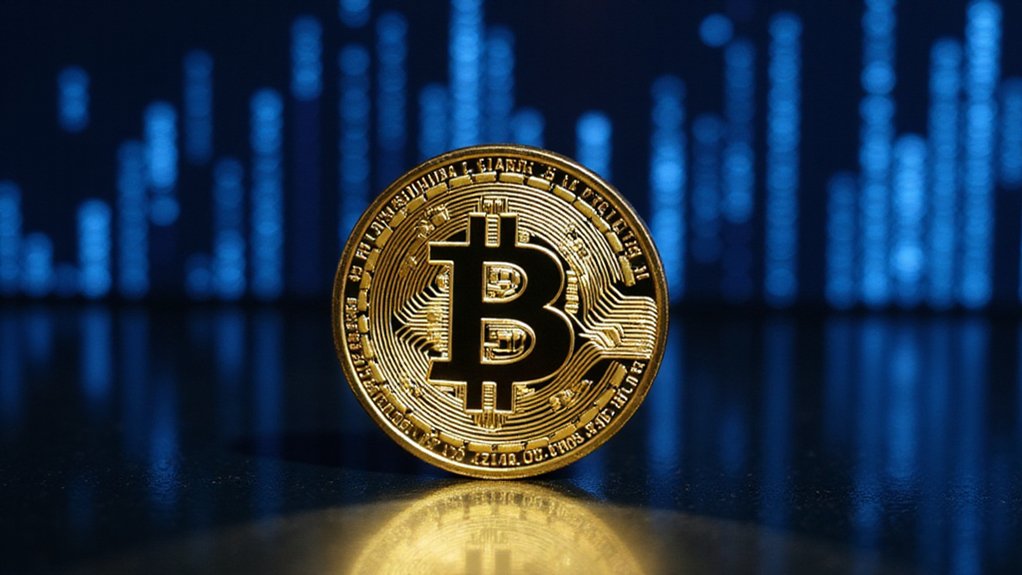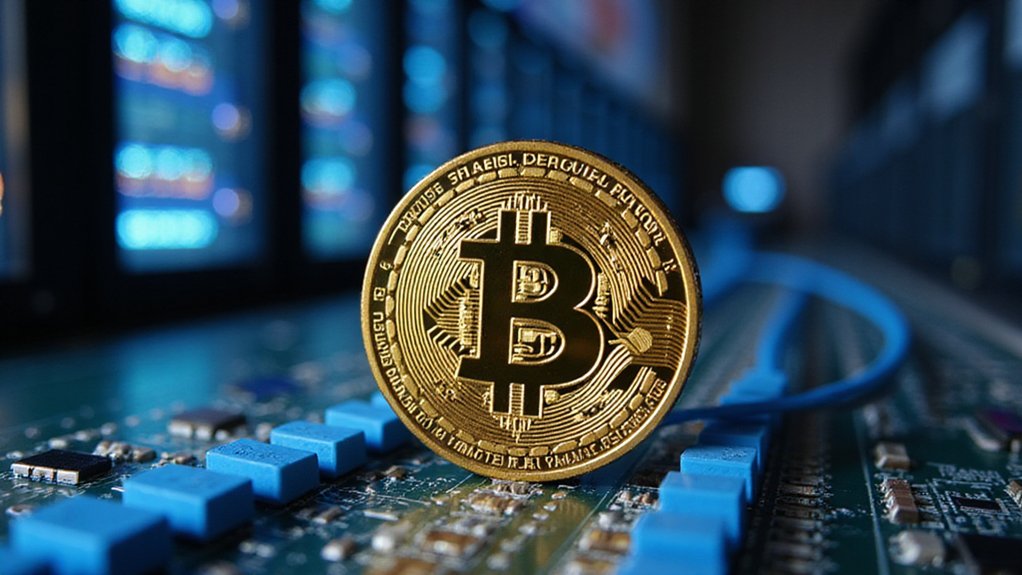Bitcoin is a revolutionary digital currency created in 2008 by the pseudonymous Satoshi Nakamoto that operates without central authority. It utilizes blockchain technology—an immutable public ledger—to record transactions across a distributed network of computers. With a fixed supply cap of 21 million coins, Bitcoin functions simultaneously as a store of value, medium of exchange, and speculative asset. Its borderless, censorship-resistant nature fundamentally challenges traditional financial paradigms (remember those 10,000 BTC pizzas?). The rabbit hole goes surprisingly deep.

How did a pseudonymous white paper published in 2008 transform into a trillion-dollar asset class that challenges fundamental assumptions about money itself?
Bitcoin, introduced by the enigmatic Satoshi Nakamoto, emerged as the world’s first decentralized cryptocurrency—a radical departure from traditional financial systems predicated on central authority and institutional trust.
This digital currency operates via a peer-to-peer network where transactions occur directly between users without intermediaries, a concept that would have seemed quixotic prior to its implementation.
At its core, Bitcoin relies on blockchain technology—an ingenious public ledger that chronologically records all transactions across a distributed network of computers.
The distributed ledger architecture creates an unalterable public record—simultaneously transparent and pseudonymous—challenging traditional financial record-keeping paradigms.
This architecture guarantees transparency while paradoxically providing a degree of pseudonymity to users, whose activities are linked to addresses rather than identities.
The blockchain’s immutability stems from complex cryptographic techniques and the consensus mechanism known as Proof-of-Work, where “miners” validate transactions and secure the network by solving computational puzzles (consuming electricity at rates that would make small nations blush¹).
Bitcoin’s scarcity—capped at an inviolable 21 million coins—stands in stark contrast to fiat currencies, which central banks can produce ad infinitum.
This mathematical limit creates a deflationary pressure that proponents argue makes Bitcoin digital gold, while skeptics question its intrinsic value.
The smallest unit, one hundred millionth of a Bitcoin (0.00000001 BTC), honors its creator as a “Satoshi.”
The cryptocurrency functions simultaneously as a store of value, medium of exchange, and speculative asset.
Its utility derives from its borderless, censorship-resistant nature, allowing value transfer without permission from financial gatekeepers.
El Salvador made history in the cryptocurrency world when it became the first nation to adopt Bitcoin as legal tender in 2021.
Market adoption has evolved from obscure tech circles (where 10,000 BTC once purchased two pizzas²) to institutional investment vehicles and national legal tender.
This evolution is regularly punctuated by halving events that reduce the rewards miners receive by 50% approximately every four years, creating scarcity and often triggering market speculation.
Bitcoin represents not merely a technological innovation but a philosophical proposition about trust, value, and monetary sovereignty.
Whether revolutionary financial paradigm or elaborate digital tulip, Bitcoin has indisputably altered our conception of what money can be.
The mining reward, which incentivizes network participation, experiences a reward halving every four years, reducing from 12.5 BTC to 6.25 BTC in 2020 and scheduled to decrease to 3.125 BTC in 2024.
¹Environmental concerns that advocates counter with renewable energy arguments.
²A transaction now worth hundreds of millions of dollars.
Frequently Asked Questions
How Secure Is Bitcoin From Hackers and Cyber Attacks?
Bitcoin’s core protocol has proven remarkably resilient against direct attacks—its blockchain remains unhacked since inception, protected by robust cryptography and decentralized consensus mechanisms.
The vulnerabilities primarily exist in the ecosystem periphery: exchanges get compromised with alarming regularity (Mt. Gox, FTX), wallets fall prey to malware, and users succumb to sophisticated phishing schemes.
While the protocol itself stands fortress-like, one’s Bitcoin is only as secure as their operational security practices permit.
What Affects Bitcoin’s Price Volatility?
Bitcoin’s price volatility stems from a perfect storm of market forces.
Its capped supply (21 million coins) creates scarcity economics while halving events periodically shock the supply curve.
Meanwhile, demand fluctuates wildly with institutional adoption, regulatory pronouncements (which can send markets soaring or plummeting overnight), and sentiment-driven trading.
The relatively thin market means large transactions can trigger cascading effects, while media coverage and social sentiment—oscillating between euphoria and despair—amplify these movements to sometimes comical extremes.
Can Governments Regulate or Ban Bitcoin?
Governments can certainly attempt to regulate or ban Bitcoin—several have tried with varying degrees of success.
While nations can effectively shutter centralized exchanges and criminalize usage within their borders, Bitcoin’s decentralized architecture presents formidable enforcement challenges.
China’s mining exodus demonstrated this reality perfectly; the network simply adapted.
Regulators face a peculiar dilemma: heavy-handed approaches merely drive activity underground or offshore, while permissive frameworks risk appearing to legitimize what some still view as speculative technology.
How Does Bitcoin Mining Impact the Environment?
Bitcoin mining exacts a profound environmental toll through its voracious energy consumption—rivaling entire nations like Pakistan or the Netherlands—while generating substantial carbon emissions (65-85 Mt CO2 annually) that potentially undermine Paris Agreement targets.
The industry’s reliance on short-lived ASIC hardware creates mountains of e-waste (30,000+ tonnes yearly), while depleting water resources at alarming rates.
Though mitigation efforts via renewables and technological innovations show promise, Bitcoin’s environmental ledger remains deeply in the red.
Will Bitcoin Replace Traditional Banking and Payment Systems?
Bitcoin is unlikely to fully replace traditional banking systems in the near term, despite its advantages in cross-border transactions and financial inclusion.
Its persistent volatility, scalability limitations, and regulatory uncertainty present formidable barriers to mainstream adoption.
Rather, a hybrid ecosystem appears more probable—where cryptocurrencies coexist with traditional finance and central bank digital currencies (CBDCs).
The financial landscape will likely evolve into an integrated system where Bitcoin serves as an alternative rather than a wholesale replacement.









